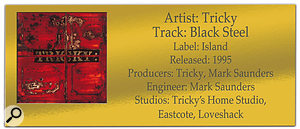Tricky's highly unorthodox approach to recording and making music led to the creation of one of the most unique and critically lauded records of the '90s.
"It was the most bizarre record I've ever worked on," says Mark Saunders about Maxinquaye, the 1995 Tricky album that, with the exception of the previously released singles 'Aftermath' and 'Ponderosa', he co-produced with the artist, in addition to taking care of the engineering, programming and mixing. "It was a complete un-learning experience and it was also a total re-learning experience. Think of how to make a record, then forget everything you've learned and start completely backwards and upside down. I could write a book about Tricky. He's such a great character."
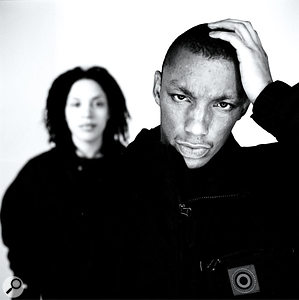 Tricky and Martina Topley-Bird, 1994.Photo: Steve Double/Retna UK
Tricky and Martina Topley-Bird, 1994.Photo: Steve Double/Retna UK
The Story So Far...
Born Adrian Thaws in Bristol, in 1964, Tricky initially made a name for himself as a rap artist on Massive Attack's first two albums during the early '90s, while hooking up with teenage vocalist Martina Topley-Bird, who became his girlfriend and musical collaborator on his own solo projects. These included his debut album, Maxinquaye (whose credits wrongly listed her as 'Martine'), and its follow-ups, Nearly God and Pre-Millennium Tension.
A protegé of Clive Langer and Alan Winstanley at London's Westside Studios in the mid-'80s, Mark Saunders gained his first engineering credit on the David Bowie/Mick Jagger cover of 'Dancing in the Street', before going freelance in 1986 and hooking up with the Rhythm King dance label. A couple of Bomb the Bass remixes led to the band's founder, Tim Simenon, asking Saunders to co-produce Neneh Cherry's Buffalo Stance album, and the success of this and its follow-up, Raw Like Sushi, then resulted in pop/dance work for acts such as Erasure, Depeche Mode, Lisa Stansfield and Yazz. The Cure's Robert Smith also hired Saunders to mix all of the singles from the band's Disintegration album, and with these broadening his musical horizons, he proceeded to work with Ian McCulloch, the Mission (UK), the Farm, the Heart Throbs, Texas and the Sugarcubes, while also doing remixes for the likes of the Human League, Mory Kanté, Wang Chung, London Beat and Jean Paul Gaultier.
Saunders recently co-produced and mixed the new album by the Shiny Toy Guns, in addition to setting up REEQ (www.myspace.com/reeqnyc), an organisation that offers artists a cost-effective new approach to mixing and mastering. You can find more information about Mark Saunder's career at www.marksaunders.com.
What really caught the attention of Cure fan Tricky was Saunders' mixing and production of the Wish and Mixed Up albums, and it's at his state-of-the-art Beat360 Studios facility in New York City, to which he relocated a decade ago, that the producer/engineer now casts his mind back to the Maxinquaye sessions, which took place during the first half of 1994.
Magpie Eyes
Taking its lead from the trip-hop created by Massive Attack, Maxinquaye went off at its own tangent and, thanks to a hauntingly atmospheric, sometimes chaotic blend of seemingly disparate samples — from Isaac Hayes to Michael Jackson — with unconventional, experimental sounds, garnered widespread attention and virtually brought the genre to the mainstream. Indeed, even though the album wasn't afforded much airplay, it still entered the UK charts at number two, largely on the strength of its extensive critical acclaim.
"We basically made a record out of different bits; the spare parts of other people's records," explains Saunders. "Every track was built around a bit of somebody else's track, or a combination of quite a few, and so the traditional method of starting by programming drums didn't apply. What's more, Tricky had a sort of three-hour concentration span, and so we really only worked in three-hour bursts. Still, he was amazingly hyper during that period of time, and I'd be trying to keep up with him. Wherever you trod on the floor there was vinyl, and he'd literally pull a record off the floor, hand it to me and say, 'Try this one,' and I'd get it in there and, just as I'd be topping and tailing one bit, he'd go, 'No, forget it, scrap that! Do this one!'
"I remember one time when I had three different bits of records all playing; none of them were in time and none of them were in tune. It was just like being stuck in the middle of three bands playing randomly, and Tricky was sitting between the monitors, nodding his head at something that was none of those three tracks. I was pacing around behind him, going, 'I can't stand this! It's just insane,' and he was saying, 'No, wait, it's fantastic!' Then, after about three minutes, he said, 'No, no, forget it. It's shit.' That was the good thing: with Tricky it was either written in stone and done, or it was complete bollocks within a few minutes. He was really extreme on that front.
"Island told me I really had to keep track of all the samples, but it was almost impossible. Tricky would take a record out and we'd sample it, and then it would disappear on the floor again, and neither of us could remember what we'd used. So at the end of the project the company was really pissed off at me because it took them about three months to clear all the rights. It was a bit of a nightmare, and I think afterwards they wrote into the contracts that the artist was responsible for the legal fees for that."
Go And Sing It
Early on, Mark Saunders also had no way of knowing precisely what kind of contribution Martina Topley-Bird would be making to the record. After all, firmly in the shadow of the amicable but larger-than-life Tricky, she scarcely said a word when Saunders first met her.
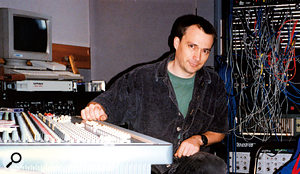 Mark Saunders in his Loveshack studio during the recording of Maxinquaye.
Mark Saunders in his Loveshack studio during the recording of Maxinquaye.
"She would come into the studio," he recalls, "murmur, 'Hi,' and he would hand her the lyrics that he'd just scribbled out and say, 'Go and sing it.' He had no concept of her listening to the track and then figuring something out. As far as he was concerned, she should just go ahead and sing it, and that's what she did, because she also didn't have any concept about making a record. She would often go in without even having heard the track once, yet most of the stuff you now hear is the very first thing that came out of her mouth. It was brilliant. It was like 'hair standing up on the back of your neck' time. The stuff she came up with was like something out of a tortured soul. She was like a modern blues artist, in a way, and fantastic, fragile melodies came out of her.
"After the first time I realised I was better off looping the whole song several times and making it, like, seven or eight minutes long and just letting her just go through it, because she naturally came up with such good stuff that we didn't want to lose anything by her thinking about it or Tricky trying to change things. And he was fine. He didn't really interfere with that process very much, making her redo stuff or whatever. Again, he had no concept of redoing anything. So Martina would just come in and do her thing, and then she'd shuffle out until the next time we needed her. It was only when I actually gave her a lift somewhere on my own that I really had a conversation with her and discovered that she was very different to what I'd seen; very bright, and with the opportunity to study oceanography before she'd put it on hold to work with Tricky."
At the same time, although musicians such as James Stevenson, Pete Briquette and FTV were brought in to play bass, guitar and drums on Maxinquaye, their parts were often treated just like samples, since Tricky was much more into them making noises than contributing anything musical.
"I played a little bit of guitar, too," says Saunders, "and I also came up with some of the hookier stuff on keyboards, although Tricky's recollection of that is different to mine. He'd sometimes ask me to give him a sound on the keyboard and then he'd just bash it, playing with his elbows or anything, and go, 'Oh, that's wicked, that's wicked!' However, after he'd leave I'd take 98 percent of the notes out and use what's left to make a melody out of it. Then, when he'd come in the next day and ask, 'Is that my keyboards I did yesterday?' I'd say, 'Yeah,' and he'd go, 'Ah, that's wicked!' I'd go, 'Yeah, it is, isn't it?' It seemed like a good idea at the time, but it kind of bit me in the butt, really, because he then actually believed what I told him.
"When 'Overcome' was released as a single, his manager called to say I had to sign a Musicians Union form stating who played on what, and when I saw the form it had Tricky doing everything; the programming, drum programming, you name it. I thought, 'That's a little cheeky,' and although I didn't remove his name, I put myself down as keyboard player. About ten minutes later Tricky called me and said, 'I don't remember you playing keyboards on that.' I said, 'Well, there's that whole bell line in the middle that I did,' and he said, 'Oh, yeah. OK.'"
Tricky's Home Studio
"I don't think the record company really knew what Tricky did," says Saunders. "He asked them to put together a small studio in his house in Kilburn [North London], and they did. This had an Akai S1000, an Atari 1040 with Logic, an Alesis ADAT, an AKG C3000 microphone, a Behringer Composer compressor and a Mackie 1604 desk. Still, Island thought they'd signed a guy who was kind of a DJ/programmer, and they told me it was just an engineering gig. However, the first day I went to his place to work, it was just littered with vinyl all over the floor. He said, 'OK, let's sample this record,' and I said, 'Yeah, sure, go ahead.' He said, 'No, no, I don't do any of that stuff.' I said, 'What do you mean?' He said, 'I don't know how to do it.'
"So on that first day we did this track, 'Strugglin'', and it was a bizarre experience for me. He'd go, 'I want to sample that record and then I want to sample this record.' I'd say, 'Well, they're two different tempos and two different tunes. I don't think it's going to work.' He'd say, 'Can we hear it anyway?' I'd end up sampling two bits of two records and it would sound like shit, but Tricky would insist: 'Just fiddle around with it.' So then I'd de-tune one of them or something, and although it was hard to predict what was going to happen, all of a sudden some combination of the two tracks would actually sound really good.
"You see, Tricky's genius is just being Tricky, and I couldn't make a Tricky record without him because I wouldn't have ever tried those things. To be honest, he had no idea of pitch whatsoever, and also not much regard for any kind of timing. He really couldn't get the concept of four-bar, eight-bar, 12-bar sections; that stuff meant nothing to him. But at the same time he also thought differently to anybody I've ever known. When I was asked to match together bits of two songs that were in totally different keys and 30 bpm apart, it didn't occur to me that by de-tuning one to slow it down, both might then gel musically at that point. I always think of it like going into a scrapyard and building a car out of all the bits you can find. You could probably build a car that would work, and although it might be the ugliest you've ever seen, it would have loads of character."
Black Steel
With 'Overcome', released just prior to Maxinquaye, adding momentum to the rollercoaster that had already been set in motion by 'Aftermath' and 'Ponderosa', the first post-album single to hit the streets then sent it into overdrive. This was 'Black Steel', a sonically hypnotic, musically audacious reworking of Public Enemy's jail-escape classic, 'Black Steel In The Hour Of Chaos', with Martina Topley-Bird's laid-back lead vocal floating over the top of pumping bass, crashing drums, bursts of steely punk guitar and assorted cacophonous sounds. Here was Tricky's stunning creativity, in all its warped glory, encapsulated within just over five-and-a-half minutes of rhythmic, semi-melodic innovation.
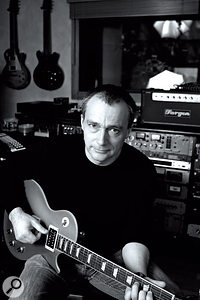 Mark Saunders at Beat360 Studios in New York City, 2006.Photo: Steve Double/Retna UK"That track actually started out with a concept," Saunders remarks. "One day, about halfway through the sessions, Tricky came in and said he wanted to do a cover of this Public Enemy song. His ex-girlfriend was Indian, and although he'd split up with her he still got on well with her mother, and she used to send him tapes of material from India. He said, 'I've got this loop I want you to hear,' and when he played it to me it was a really bad quality recording; probably cassette-to-cassette. It wasn't an old, vibey Indian record; it was more like an '80s Indian track, complete with Linn Drum, and that was the starting point for 'Black Steel'. Tricky asked me to loop that beat, and the tape was so hissy that I had it in mind to de-noise it with the Pro Tools plug-in that I'd discovered and used on 'Strugglin'' when we'd gone for the cassette mix.
Mark Saunders at Beat360 Studios in New York City, 2006.Photo: Steve Double/Retna UK"That track actually started out with a concept," Saunders remarks. "One day, about halfway through the sessions, Tricky came in and said he wanted to do a cover of this Public Enemy song. His ex-girlfriend was Indian, and although he'd split up with her he still got on well with her mother, and she used to send him tapes of material from India. He said, 'I've got this loop I want you to hear,' and when he played it to me it was a really bad quality recording; probably cassette-to-cassette. It wasn't an old, vibey Indian record; it was more like an '80s Indian track, complete with Linn Drum, and that was the starting point for 'Black Steel'. Tricky asked me to loop that beat, and the tape was so hissy that I had it in mind to de-noise it with the Pro Tools plug-in that I'd discovered and used on 'Strugglin'' when we'd gone for the cassette mix."I'm not sure where the whiney backward guitar riff came from. It may well have been something I played, and then Tricky would have wanted it backwards. I mean, you couldn't play a riff without him going, 'No, no, that sounds too normal,' whereas if you made a mistake he'd go, 'Yeah, I love it, I love it! Now put it down an octave and make it backwards.' That's probably how that part came about, and immediately afterwards Tricky was like, 'That's it, we're done!'"
Save, that is, for Martina's contribution. Nevertheless, while she got the call, he couldn't be bothered to write out all the lyrics, and so what she ended up singing was just a repetition of the first two verses, captured in one take.
"She sang to this loop with basically no music to guide her," Saunders explains, "and yet she came up with this melody that had such a great vibe. She came up with all the songs' melodies, and not one of them did she work out beforehand. She didn't even listen to the track before she went in. And she was also one of the quietest singers I've ever recorded. I had the C3000 cranked up really loud, and this meant if she coughed it would rip your head off."
Needs More Techno Punk!
Recorded at Tricky's home studio, the Indian loop, backwards guitar and lead vocal were, as far as he was concerned, all that the song required. Next, fast-forward to sessions at Saunders' Canalot-based Loveshack facility in London's Notting Hill, where a 32-channel Soundcraft Spirit console was supplemented by Pro Tools hardware and Cubase Audio, during which the co-producers attended a gig featuring a band that included Martina's brother. The techno-rock outfit that performed afterwards was called FTV, and the following day, Tricky remembered during a phone conversation with his manager that he'd invited the band to play on his record. Unable to recall what the musicians sounded like, he nevertheless gave her the go-ahead to have them turn up three weeks later.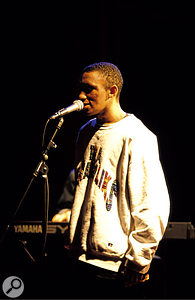 Photo: Steve Double/Retna UK
Photo: Steve Double/Retna UK
Tricky on stage in 1995, the year of Maxinquaye's release.
Given the limited amount of space at Loveshack, studio time was instead booked at MCI console-equipped Eastcote, across the street from Canalot, and when the date drew near and Tricky didn't know how to use the band, Saunders pointed out that the only track without much instrumentation was 'Black Steel'. Tricky was happy with the song as it was, but Saunders told him whatever was added could always be removed.
"I thought the track was alright, but all of the others had more crusty, groovy stuff going on, as well as more of a hooky melody," says Saunders, "I therefore laid down what we had to ADAT on the morning that the band was coming in, and then set everything up for FTV's drummer, guitarist, keyboardist and bass player. I don't think it had occurred to anyone beforehand that they should be given the track to listen to. And for our part, had we remembered hearing them, we probably wouldn't have used them. The drummer played like a drum machine, and all of their stuff was like fast techno music, performed by a real band, totally unlike the vibe of the Tricky record.
"Still, I had it in my head that some kind of punk style could be good. To me, Public Enemy were like the punk rockers of the hip-hop world, and so although Tricky wasn't really interested, I thought it was really worth giving these guys a chance. Then again, what really worried me was that, when we were setting up the drum sound and the drummer was hitting the toms for me, Tricky suddenly sat up and said, 'Just record that! That's wicked, that is!' I was thinking, 'Oh, shit. These guys have come all the way from Manchester and this is what we're going to end up using.' I said, 'OK, yeah, we'll do that,' and then Tricky went back to not really paying much attention while I got all the other stuff going.
"Before I knew what they were really like, I saw the keyboard player show up with a Korg M1 and I thought, 'Oh God, I hope it isn't going to be like tinkly Rhodes sounds,' but he was great. All of the sounds in his Korg were like distorted guitar, pad things, so he played much more like a guitarist than a keyboardist. At the same time, I said to the drummer, 'Let's go for something different to what you normally do. Just play loads of crashy, splashy, Sex Pistols kind of stuff.' And he was really happy to do that, because he was used to playing to a drum machine or like a drum machine and not having much leeway to lash out and be a thrashy punk drummer. So he was really enthusiastic about the idea, and in the end they were fantastic."
Overcome
"They basically had to write something that would fit with Martina's existing vocal, and I think they played to the track six times. I remember thinking during the first run-through, 'Wow, they really get this,' because I'd been concerned about how the hell it was going to work and having to cobble something together afterwards. However, what they laid down just captured the right kind of vibe to me, and so I was giving them loads of positive feedback. Tricky, however, didn't even speak, I can't remember him saying one word to the band at that point, and I felt kind of bad because they were really happy to come down and have anything to do with somebody who had a major record deal. I think he still had it in his head that he was just going to use the drummer warming up on the toms, and he pretty much said this at the end of the session.
"I'd already learned to not say anything, defending the band would only make things worse, and so that was that. I actually thought they would be great for Tricky, even backing him when he played live, but in the end they just appeared on 'Black Steel' and I was really happy that at least one track on the record had some raw energy. You see, I'd been working on this stuff for a while and it was all really, really slow, and I thought FTV pulled off an amazing job. I didn't really have to give them musical direction in terms of what chords to try and what was or wasn't working. They all just set up and played together, and they got it right from the first run-through. The six passes that we did were mostly down to me telling the drummer to play more and more wacky, over-the-top fills.
"When Tricky wasn't around, I imported their stuff into Cubase, picked the bits that I liked and compiled them underneath Martina's vocal. And although I was really excited about it, I waited at least two weeks before I played it to Tricky. I actually had it playing one morning when he walked in the room, and he immediately went, ''Ere, what's that? That's wicked!' 'It's 'Black Steel'.' 'It sounds great!' What a relief that was. Then he listened to it again and he said, 'Oh, I've got an idea, I've got an idea! Give me a mic.' That's when he went it and recorded himself saying, 'Switch in, switch on, switch off.' I just created some space for that, and that was pretty much it.
"I still had it in my mind to clean up the cassette hiss and then do a better mix of the overall track with all the bits that I'd compiled, but I never got to do that. The next thing I knew, they were mastering it, and so it was the classic rough mix that ended up on the record. The track may have been pristine going to tape, but the fact that it was chopped up and compiled in a Pro Tools system that didn't have enough room for all the individual tracks to go in together meant that it just underwent a rough sub-mix. Still, that song was never really about the pristine quality of the drums. It was about a guy named Tricky and my attempts to make his material more appealing to the Western ear."
Sampling The Samplers
What with the main man's loose approach to music making — dig some records up off the floor, sample them and then go from there, direction unknown — there were only sporadic moments of cohesive vision. Yet, according to Saunders, these did occur, such as the time when Tricky entered the studio with 'a great idea for a loop', incorporating the samples from Isaac Hayes' 'Ike's Rap II' that had been used on Portishead's yet-to-be-released 'Glory Box' to create the trip-hop classic, 'Hell Is Around The Corner'.
"We did the whole track," Saunders recalls, "and Tricky then did his usual thing, calling the manager and telling her, 'This is fantastic! You've got to come and listen to the next single!' At that time we were working at my own Loveshack studio inside Canalot [in Notting Hill], and the manager was just up the road, so she came in and she stood in the doorway as he played it to her, and I saw her jaw drop. She said, 'Tricky, I can't believe you did that.' Tricky went, 'What? What are you talking about?' I could see he was starting to smirk, he knew what she was talking about. She said, 'You know Portishead have used this,' and he said, 'No, I had no idea!' He was laughing, and it turned out that she'd given him a cassette of some rough mixes off the Portishead album.
"The thing is, he could have listened to it, completely forgot he had heard it and then woke up the next morning and thought, 'I've got a great idea for a loop!' I don't think he meant to rip anyone off, but once his manager pulled him up on it he probably remembered and then tried to bluff his way out. Still, he didn't really care that much. With 'Hell Is Around The Corner' it was obvious what he'd done, whereas with the other tracks it was usually a combination of two different things going on; two different samples creating something unrecognisable, supplemented by S1000 drums to make it more solid. His favourite phrase was 'Let's drop it down the octave!' And as time went on I figured out that he generally liked stuff that was really slow and grainy and screwed-up.
"I remember when we were doing 'Strugglin'' at his flat. I loved that track, it was just so dark, and we took the loop down an octave, so obviously there were a load of sub-frequencies we couldn't hear through a pair of NS10 monitors Well, a neighbour knocked on the door and said, 'I'm sorry to trouble you, and it sounds really good, but I'm trying to eat my dinner and the plates are moving across the table.' There was just so much sub-bass going through to this apartment below, and we had no way of knowing."

